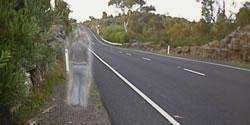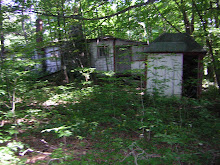 The roads which criss-cross southern Vermont and eastern New York are replete with stories of strange encounters. Tunic Road has its accounts of phantom soldiers; UFOs have been sighted by drivers along Route 7 and also White Creek Road; Route 7 has also been the sight of alleged Bigfoot sightings, as has Prospect Mountain.
The roads which criss-cross southern Vermont and eastern New York are replete with stories of strange encounters. Tunic Road has its accounts of phantom soldiers; UFOs have been sighted by drivers along Route 7 and also White Creek Road; Route 7 has also been the sight of alleged Bigfoot sightings, as has Prospect Mountain. One day in the 1970’s, author David J. Pitkin reports, he had a strange roadside encounter of his own while driving to and from Bennington. On his way there from his home in Troy, New York, he happened to spot a man hitchhiking in the distance. As he grew closer, the man’s ragged attire and unkempt hair became apparent, and his weaving back and forth made it quite apparent that the man was blind drunk. Finding in favor of prudence, Pitkin sped by without stopping.
On his return trip, he saw that the man had changed lanes and was now hitchhiking in the opposite direction, toward Troy. Pitkin had intended to keep driving and pass the dubious looking man once more, but just then it began to pour rain. Taking pity, he pulled over and let the man in. The reeking, obviously intoxicated man got into the car. He was nearly incomprehensible, and it was not clear where he was going. They drove in silence, until they reached the outskirts of Troy and stopped at a red light, the man mumbled “This is good enough.” They pulled over and the man stumbled out of the car without closing the door. Pitkin leaned over to close it, and when he looked up, the man was gone. “I scanned the full 360 degrees around my car, for at least a hundred yards in every direction, for at least a hundred yards in every direction. He was nowhere to be seen. Where could he have gone? There were no nearby doorways where he could hide. He had just vanished into thin air.”
Stories of this sort are not rare. Folklorists recognize this as a variant of the “Vanishing Hitchhiker,” a class of urban legend, though the term contemporary legend is gaining ground as the preferred classifier. Modern folklore expert Jan Brunvand calls the Vanishing Hitchhiker narrative “the classic automobile legend.”
“This returning ghost tale,” Brunvand states, “was known by the turn of the century both in the United States and abroad. It acquired the newer automobile motif by the period of the Great Depression, and thereafter spawned a number of subtypes with greatly varied and oddly interlocking details, some of which themselves stemmed from earlier folk legends.”
In one of the most common types, the story centers on a young girl asking for a ride home. Before the driver and passenger reach her house, however, the girl has vanished into thin air. The driver proceeds on to the house anyway, typically because she has left something behind in the car. When he knocks on the door, the person who answers (usually her father) tells the driver that his daughter died on this very day, X amount of years ago. In other versions, the hitchhiker may be a man or an elderly woman dressed in black, who deliver some sort of prophetic message.
In most cases, these stories, like others classed as contemporary legend, are FOAF (friend-of-a-friend) tales, passed on from person to person as a morphing, undocumented narrative, typically introduced with a statement like “this happened to someone my sister’s friend knows,” or “someone who went to my co-worker’s college said…” Therefore, folklorists tend to treat these stories as fictional- socially meaningful, perhaps, but without root in an event taking place in real space time. This becomes problematic, however, when one is confronting a first hand account. It is certainly more awkward to declare something a legend when the something is a specific person coming forward with what they maintain is a personal experience they had in a real place and time. Pitkin’s experience is not a unique occurrence, either; a number of other first hand accounts of vanishing hitchhikers exist. The most well known of these is probably that of a man named Anton Lagrange, from Durban, South Africa, which was documented in an article in FATE by Cynthia Hind.
What are we to make then, of these stories? Are they all lies concocted by a few individuals, inspired by FOAF tales, or do certain concepts taken for granted in the study of folklore beg reexamination? Perhaps the quandary is best stated by University of Pennsylvania folklorist Bill Ellis when he says, “…The major limitation of the folklorist’s perspective is that it presumes that if a story is found in variant form attached to many places and times, then that is proof presumptive that it never happened at any place or time… granted, the vanishing hitchhiker circulates widely and usually in anonymous of friend-of-a-friend form. But does that in itself impugn every firsthand account?”
It does not, I would venture. Too many examples exist to negate the idea that all, or even most, types of FOAF tales arise out of the ether of human imagination without some analogue or antecedent in actual incidents and experiences. Ellis cites the work of Gary Alan Fine, who in researching urban legends of mice in Coca-Cola bottles, found numerous documented cases in which various rodents had been found in different kind of soda containers. Similarly, the immensely popular “alligators in the sewer” tales seem to be rooted in verifiable incidents. Documentation of an apparently quite real problem with alligators in the Manhattan sewer system in the 1930’s has been found in the NY Times and in records of the office of the New York City Commissioner of Sewers.
Folklore is a kind of running social narrative that explores the boundaries of what we know or believe to be real. Perhaps the survival and popularity of many of FOAF tales and contemporary legends, and the reason that they are often believed, is based on an instinctive sense on the part of the population at large that the world really is stranger than we ever give it full credit for, and sometimes, just sometimes, the weirdest things anyone can think up really do happen.
Sources:
Pitkin, David J. Ghosts of the Northeast, 2002
Brunvand, J.H. The Vanishing Hitchhiker: American Urban Legends & their Meanings, 1981
Ellis, Bill. Aliens, Ghosts & Cults: Legends We Live, 2003
Hind, Cynthia. “Girl Ghost Hitches Ride.” FATE July 1979



1 comment:
Sorry for the faulty link!
The actual address of the post containing the link to this story is:
http://time-slips.blogspot.com/2008/04/vanished-in-vermont_07.html
Great story - great blog!
Post a Comment